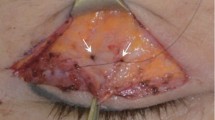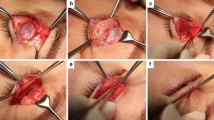Abstract
Background
Most patients with blepharoptosis prefer to undergo a double eyelid operation and a ptosis repair simultaneously to achieve the optimal cosmetic and functional result. However, it is difficult to achieve symmetry in patients with blepharoptosis.
Methods
Surgery was performed on the levator aponeurosis or frontalis muscle to correct blepharoptosis while double eyelid surgery was simultaneously performed to correct blephroptosis in 264 patients over the past 15 years. This report describes 39 representative cases of unilateral congenital blepharoptosis and 30 representative cases of bilateral congenital blepharoptosis. In cases of unilateral ptosis with good or fair levator function, a levator resection or plication was performed, and the position of the lid margin was adjusted to 1 to 2 mm below the upper limbus. Cases of severe unilateral blepharoptosis were corrected by frontalis muscle flap, orbicularis oculi muscle flap, or frontalis myofacial flap, and the height of the double eyelid was created to be 1 to 2 mm less than the height on the normal side. The position of the lid margin was adjusted to the level of the superior limbus, and the height of the lid crease of the ptotic eye was determined to be according to that on the nonptotic side. For bilateral ptosis patients with equal levator function, the height of the double eyelid was designed symmetrically. Bilateral blepharoptosis patients with unequal levator muscle function should have the double eyelids on both sides created the same as in normal cases, and they must be grafted in proportion to the severity of the blepharoptosis. If the results are unpredictable, the two-stage operation should be performed.
Results
Only 30% of the eyelids in this study were perfectly symmetric after the blepharoptosis operation, with 70% asymmetric. These 70% showed good symmetry immediately after surgery, but asymmetry occurred 6 months after the operation.
Conclusion
In blepharoptosis surgery, different techniques for double eyelids must be applied according to the method of ptosis correction used. Usually, the height of the double eyelid on the ptotic side should be a little less than the normal double eyelid height on the nonptotic side. However, it is difficult to achieve symmetric double eyelids in blepharoptosis patients.







Similar content being viewed by others
References
Ben Simon GJ, Lee S, Schwarcz RM, McCann JD, Goldberg RA (2005) External levator advancement vs Muller’s muscle-conjunctival resection for correction of upper eyelid involutional ptosis. Am J Ophthalmol 140:426
Carraway JH (2003) Combining blepharoplasty with upper eyelid ptosis correction. Aesth Surg 23:59
Park DH, Lee SJ, Song CH (2005) Recurrence of blepharoptosis after a superiorly based muscle flap: Treatment by frontalis muscle advancement. Plast Reconstr Surg 116:1954
Park DH, Ahn KY, Han DG, Baik BS (1998) Blepharoptosis repair by selective use of superiorly based muscle flap. Plast Reconstr Surg 101:592
Park DH, Choi SS (2002) Correction of recurrent blepharoptosis using an orbicularis oculi muscle flap and a frontalis musculofascial flap. Ann Plast Surg 49:604
Fernandez LR (1960) Double eyelid operation in the Oriental in Hawaii. Plast Reconstr Surg 25:257
Souther SG (1974) The Fasanella-Servat operation for ptosis of the upper eyelid. Plast Reconstr Surg 53:123
Jordan DR, Anderson RL (1990) The aponeurotic approach to congenital ptosis. Opthalmic Surg 21:237
Sayoc BT (1974) Surgery of the Oriental eyelid. Clin Plast Surg 1:157
Mustardè JC (1982) A pragmatic approach to ptosis correction. Adv Ophthal Plast Reconstr Surg 1:69
Thornton WR (1994) Combined approach of ptosis and blepharoplasty surgery. Facial Plast Surg 10:177
Author information
Authors and Affiliations
Corresponding author
Rights and permissions
About this article
Cite this article
Park, D.H., Kim, C.W. & Shim, J.S. Strategies for Simultaneous Double Eyelid Blepharoplasty in Asian Patients With Congenital Blepharoptosis. Aesth Plast Surg 32, 66–71 (2008). https://doi.org/10.1007/s00266-007-9050-5
Published:
Issue Date:
DOI: https://doi.org/10.1007/s00266-007-9050-5




